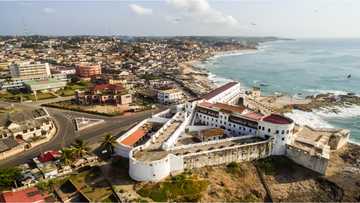Complete List of Cocoa Growing Districts and Regions in Ghana
Are you wondering about cocoa growing towns in Ghana? Indeed, cocoa was Ghana's gateway to agricultural commercialisation, the trade becoming prevalent in the early 19th century. Today, the cash crop has become Ghana’s chief agricultural export and primary cash crop, making them the world’s second-largest exporter after Ivory Coast. The cocoa growing districts in Ghana have made an immense contribution to the Ghanaian economy, creating great sustainability for the country. What are these cocoa growing regions in Ghana that are earning the West African state massive foreign exchange?

Source: Getty Images
Ghana's massive cocoa production is facilitated by smallholder farmers that traditionally plant their cocoa randomly under thinned forest shade. Therefore, they create a low-input cultivation system that utilises existing forest soil fertility and shade. The culture is prevalent in all cocoa growing areas in Ghana.
Of course, some areas do not produce enough output to qualify as cocoa growing regions, but they add a sizeable share into the overall export output. Which are these regions that are termed as exclusive cocoa growing districts because of their massive output?
Cocoa growing districts in Ghana
Cocoa’s cultivated in six regions in Ghana. These are Western, Central, Brong Ahafo, Eastern, Ashanti and the Volta regions whereby the average rainfall is 1,000 – 1,500 millimetres per year. Ordinarily, the cash crop's year starts in October. Additionally, a smaller mid-crop cycle begins in July.
These six tropical regions around the equator possess the ideal climatic conditions for growing cocoa. Currently, there are millions of people involved in cocoa farming in Ghana.
1. Western region

Source: UGC
Ghana’s Western Region experiences the highest rainfall and possesses lush green hills and fertile soils. That is why it is preferred for cocoa production in Ghana. Ghana’s Western Region enjoys a long coastline that stretches from South Ghana's border with Ivory Coast to its boundary with the Central Region.
The Western Region covers an area of approximately 239,221 square kilometres, which is 10% of Ghana's total landmass. The area has 17 agricultural districts and has 75% of its vegetation within high forest zones.
These advantageous climatic conditions give the region significant economic importance within the context of national development. They account for a large proportion of Ghana’s cocoa production.
2. Central region

Source: Getty Images
The Central region is bordered by Ashanti and Eastern region to the north, Western region to the west, the Gulf of Guinea to the South and Great Accra region to the east. Other than it being one of the best areas for cocoa production in Ghana, the area is renowned for its elite higher education institutions and immense industrial minerals.
This region was historically part of the Western Region. Cocoa production in the Central region is predominant in Assin, Twifo-Hemang-Lower Denkyira and Upper Denkyira. The other areas, like Assin, concentrate on oil production. This means that agriculture is the primary economic activity of the Central region, accounting for about 52% of the people’s occupation.
The number of ecological cocoa plantations is rising fast in this region. This has resulted in more and more people working in the cocoa business, whether in smallscale or largescale plantations.
3. Brong Ahafo area
Brong Ahafo is the second-largest area in Ghana covering 39,558 square kilometres and includes 22 administrative regions. The region experiences high humidity averaging over 75% the entire year. Additionally, Brong Ahafo enjoys a moderate to a high amount of rainfall, making it ideal for cocoa farming. However, the northern parts of Brong Ahafo experience low rainfall.
70% of this Ghanaian area is under agricultural activity that produces great output every year. The predominant vegetation is forest, transitional and savanna in the southern, middle and northern parts respectively.
This area has approximately 223,739.03 hectares of cocoa. Although most of the cocoa plants are overaged (above 30 years), there has been massive replanting initiatives to resuscitate the sector and boost its production.
4. Eastern region
If you have been wondering, “which region produces more cocoa in Ghana?” then you ought to consider the Eastern area. Many people have identified the Eastern region as the birthplace of Ghana’s burgeoning cocoa industry.
The first cocoa farm in Ghana, which was the first source of seedlings for other cocoa farming regions in the country was planted in 1879. Tetteh Quarshie facilitated this at Mampong Akuapem, a 50 minutes’ drive from Accra.
The Cocoa Research Institute of Ghana (CRIG) is located in the Eastern region at Tafo. Its main responsibility upon establishment was to investigate diseases and pests that reduce cocoa production. Today, the institute has expanded its mandate to perform scientific research into various aspects of cocoa production.
5. Ashanti region
Are you wondering about the cocoa growing areas in Ashanti region? Indeed, the Ashanti area is endowed with abundant arable land that supports the productions of cash crops such as coffee, oil palm, citrus cashew, and many others. These are the primary cocoa districts in Ashanti region:
- Atwima Mponua
- Sekyere East
- Amansie West
- Amansie Central
- Ahafo Ano North
- Bosomtwe Atwima
- Kwanwoma, Adansi South
- Adansi North, Offinso
- Ejisu Juaben
- Asante Akim South
- Ahafo Ano South districts
The Ashanti Region has a forest cover of approximately 3,180 square kilometres that represents about 22.5% of Ghana's forest reserves. Cocoa is mostly grown as a mono-crop in plantations. However, they are interplanted with other food crops.
6. Volta region

Source: Getty Images
The Volta Region is Ghana's fourth-largest area and covers about 20,572 square kilometres. The primary occupants are the Ewe people, although migrant groups inhabit the Northern zone from mainly Akan-speaking regions of Ghana.
The area is endowed with great natural resources and fertile soils, making agriculture the primary source of income for most households. Cocoa’s grown in the Northern and Central zones of the Volta Region.

Source: Original
The above represents the cocoa growing districts in Ghana that account for the country’s biggest proportion of the cash crop. It is evident that cocoa farming in these regions provides both formal and informal employment and form the base of agriculture in Ghana’s economy.
Yen.com.gh on November 21 featured an interesting story about a 55-year-old taxi driver that was crowned the National Best Farmer. The winner confessed that he had attempted numerous times to go abroad, and was also struggling with his taxi business. These struggles pushed him to attempt a new venture.
That is how he started working as the coordinator of Head Load Secretariat. The body is responsible for rice imported into Ghana via the western corridors of Elubo, Sampa, and Nkrankwanta. He increased revenue collection in the region.
Source: YEN.com.gh







